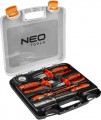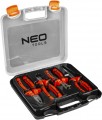Total number of items
The total number of core items included in the set.
In this case, the main items are all devices that are directly used during work: non-separable tools (traditional wrenches, hammers, pliers ...), elements of collapsible tools (for example, a ratchet for removable heads and 5 such heads will be considered 6 units) , as well as accessories (such as extensions or universal joints). Additional accessories — such as lights — may or may not be included in this count, depending on the manufacturer; however, there are usually few such accessories, and they do not fundamentally affect the total number of items.
The most modest modern tool kits include
up to 25 units. However, such kits are very popular — they are inexpensive and at the same time can be very versatile.
25 – 50 items is still quite a small number,
50 – 75 pcs can be called an average,
76 – 100 items are more than average, and the most extensive modern sets can include
100 – 150 items or even
more.
The general rules for choosing this parameter are obvious: a more extensive set, usually, is more multifunctional, but more expensive, weighs more and takes up more space. It is also worth bearing in mind that with a similar number of items, the specific assortment of these items in differ
...ent sets may be different; so when choosing, it is worth specifying not only the number of tools, but also their specific composition.Screwdriver
Number of classic
screwdrivers supplied in the kit. Note that some modern tool kits include
only screwdrivers, without any other fixtures or accessories.
Despite the proliferation of screwdriver handles with interchangeable bits (see above), traditional non-separable screwdrivers also remain popular nowadays. One of their advantages over collapsible counterparts is the convenience of working with different types of fasteners at the same time: keeping several separate screwdrivers with different sizes and types of tips on hand (for example, two flat and two cross-shaped ones) and taking a tool as needed is much more convenient than constantly changing bits on the screwdriver handle. Other advantages include strength, reliability, as well as matching the size of the handle to the size of the tip and the expected features of the work. So, screwdrivers for large fasteners are equipped with thick handles that allow you to develop a lot of effort; and with small tips, handles of small thickness are used, contributing to precision and accuracy.
As for the quantity, it is worth considering here: a larger number of screwdrivers gives more opportunities, however, the specific set of such tools (and opportunities) in different kits may be different. These details will not hurt to clarify before buying. Also note that it hardly makes sense to look for numerous screwdrivers for simple work — in suc
...h cases, a handle with bits may be more convenient.Voltage indicator
A screwdriver-shaped device consisting of a thin metal tip, a transparent dielectric handle, a high resistance resistor, a contact plate on the back of the handle, and a signal lamp. Designed to determine the phase wire, the presence of voltage in the network, diagnostics of automotive on-board networks.
Voltage indicators with batteries allow you to ring the electrical network for breaks. Advanced indicator screwdrivers are suitable for non-contact detection of wiring under a layer of finishing material and can be equipped with a light and sound informant.
Automotive indicators operate with a voltage of 6 to 24 V (less often — from 3 to 48 V) and can be equipped with a "crocodile". The rest are designed for voltages of 230 V and 400 V (sometimes up to 500 V).
Wire stripper
The stripper is an indispensable assistant for wiring electrical networks, with which you can cut and strip the ends of cable cores. Some strippers also allow stranding — the final capabilities of the stripper depend on the specific modification of the tool. Note that there are separate categories of tools on the market for different types of cables. So, there are strippers for power wires, coaxial cable, twisted pair, etc. Additionally, strippers are divided into manual models, semi-automatic and automatic.
Also in kit
Additional items included with the toolbox but not listed above. Here are some of those items:
— Adapter. Adapter from one type of mount to another. Quite often, adapters are designed to fit magnetic bits (see above) with a hex shank into a tool that uses a landing square, but there may be other options — for example, adapters between different sizes of the mentioned squares (see above).
— Holder for bits. A specific type of adapter designed to mount bits with a conventional hex shank in screwdrivers where a shank with a notch for a retainer is required. In extreme cases, they can also be used as improvised screwdrivers. Several holders can be supplied, in such cases they usually differ in length.
— Level. A tool for assessing the position of a particular surface. The simplest levels are for testing whether a surface is horizontal or not; however, tool kits usually include more advanced fixtures that allow you to also control verticality, and in some cases also check compliance with a 45 ° tilt and even measure a specific angle of deviation from the horizontal / vertical.
— Depth limiters. They are used together with drills (see above). They allow you to set the maximum drilling depth — the tool simply will not go further; this is useful in cases where you need to make holes of a given depth.
— Telescopic magnetic probe. A device in the form of an extendable rod (like an antenna or a pointer) with a strong permanent magnet at...the end. Facilitates the collection of small metal parts — for example, crumbled bolts or bits — including and in hard-to-reach places (like the space under the cabinet or a narrow gap between the boards).
— Lamp. Classic flashlight for lighting in dark places.
— Tester. He's an indicator. A specialized screwdriver for searching for a phase in electrical networks during electrical work. The indicator rod is almost completely covered with insulation, and a light bulb is located in the transparent handle. Such a device can also be used as a classic screwdriver, but it is not designed for applying great efforts — the main purpose is to search for the phase.
— Fastening devices — for example, screws with dowels. In normal cases, it is more convenient to buy fasteners separately, for specific needs; however, there are situations when the "emergency stock" provided in the kit is very handy.
This list is not exhaustive — manufacturers may provide other equipment, sometimes very specific.

